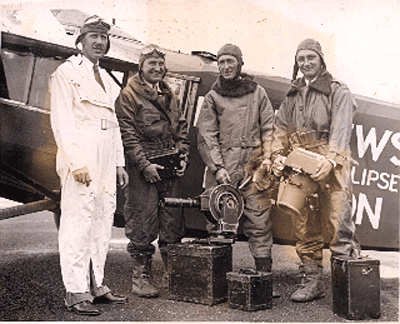

Thousands See solar Eclipse
Atmospheric Oddity Reported by North Island Navy Plane
May 5, 1930
Curious hundreds on hand at Honey Lake Science campsite; Phenomena “shot” by cameras; lakeshore is “Landing Field.”
Scientists, military observers, movie news men, school children and hundreds of persons in the ordinary walks of life were present at a point near the edge of Honey Lake about seven miles east of Milford last Monday morning to witness a planetary phenomenon; a total solar eclipse.
Automobiles, four movie cameras, two naval airplanes, two refractory telescopes, spectrographs and an observation platform were only a part of the equipment used at the campsite of the scientists to record the various situations presented when moon passes between sun and earth.
Totality of the eclipse, throwing the countryside in almost total darkness, took place shortly after 11 a.m. and lasted only for a second and a half. The shadow which obscured the sun traveled at the rate of 1800 miles per hour.
Visible in the Pacific. The eclipse was first visible in the Pacific Ocean at a point some 500 miles south of Hawaii. At this place the eclipse was annular in form, the shadow not quite obscuring the sun totally, the moon appearing as a dark sphere within the outer edge of the sun. The eclipse became total shortly before the shadows reached California, remaining thus until it reached a point in Montana where it again became annular. The course of the phenomena was then traced through northeastern Canada where it disappeared in the North Atlantic. The path of the total eclipse was about a half mile wide on the face of the earth. This path started in a northeasterly direction from about 10 miles north of San. Francisco, over the southern tip of Honey Lake and thence to northwestern Nevada, southeastern Oregon, Idaho, Montana and Canada.
Crowd on hand. A large crowd was on hand when Lieutenant L. H. Gehres and chief photographer Lieutenant J. M. F. Haase of the North Island Naval Air Base at San Diego, comprising the chief section of the Navy’s eclipse observation force at Milford, touched the improvised landing field after attaining an elevation of 18,000 feet where they recorded, photographically, the actions of the sun and moon. Their plane, a navy biplane, equipped with one motor, was also fitted with a specially constructed camera. The navy fliers reported upon landing that a peculiar cloud formation, similar to a sky-writer’s trail, hovered around the 18,000-foot ceiling.
Lieut. Gehres, himself highly trained in astronomy, stated that he had never witnessed anything in the clouds to compare with this peculiar formation. He reported sighting the atmospheric oddity about a mile and a half south of the Honey Lake campsite. The flier-astronomer was of the opinion that the cloud formation, which he described as being extremely unusual, was probably due to the effect of the eclipse itself.
Gehres also stated that when flying through the formation of the clouds at this point the mist was so thick that it was almost impossible for him to see his instrument. Haase had his camera pointed directly at the eclipse white it was in totality and cranked feverishly the full time. He was of the opinion that he had obtained some remarkable “shots” of the phenomena. Both of the fliers were outfitted with electrically heated flying togs during their flight.
Movies made. Besides the scientific observers present on the shore of Honey Lake at the time of the eclipse there was also a battery of movie news photographers which microphoned the oddity. There was also a big Sikorsky naval observation plane besides the plane which carried Gehres and Haase. This was a two motored amphibian affair, carrying Lieutenant W. M. Harvey, two mechanics and a photographer. The entire squadron left the North Island base Friday.
A Ryan monocoupe, of the same type which carried “Lindy” to Paris on his epochal flight, bore two university scientists, who also made scientific studies on their flight.







